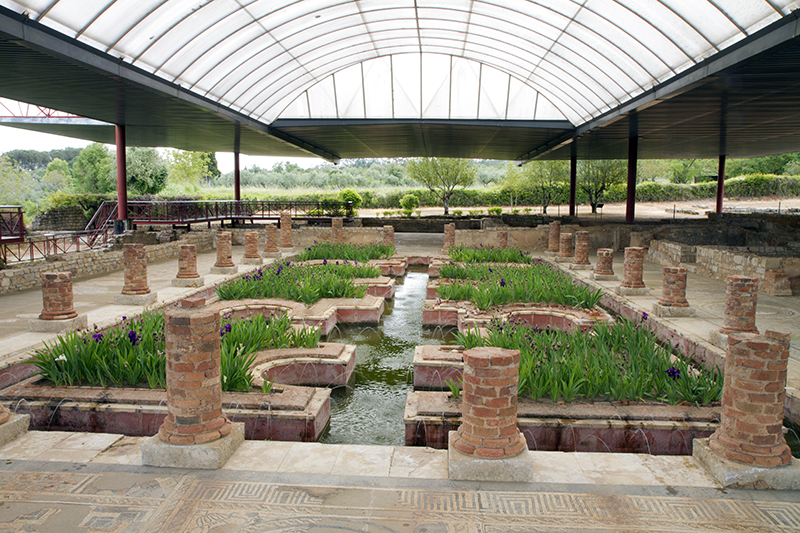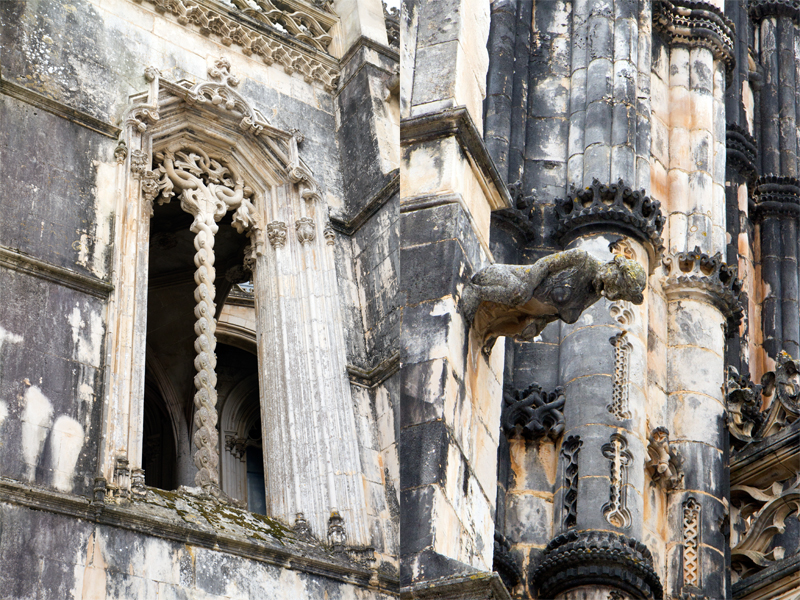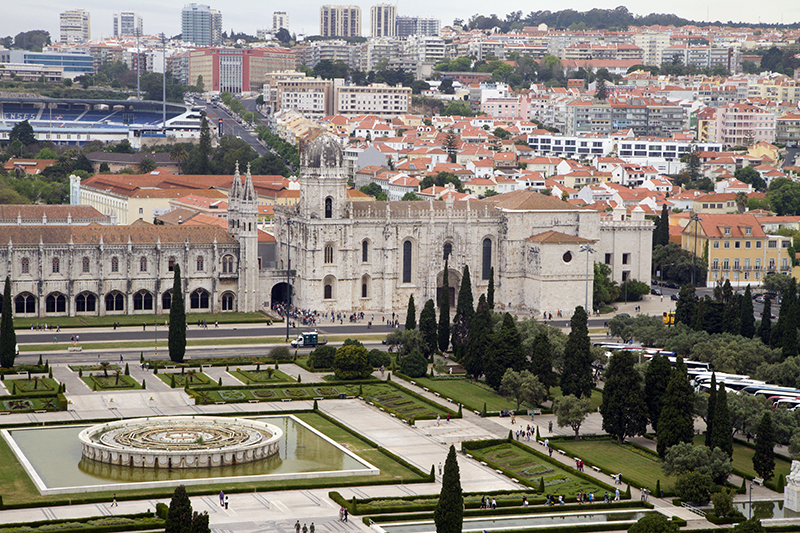After Coimbra, we spent a few more days in the area and went to the Natural Park da Serra da Estrela which includes the highest mountains in Portugal. We stopped at the highest peak where there is a weather station and what looks like army radar installations. The weather was good, but cold and very windy – you can still see that there is a lot of snow left on the ground and this was at the end of May.
We did some walking in the park too but no great pictures. We stopped for lunch in Manteigas, right at the center of the Parque Natural da Serra da Estrela where we saw an old car rally but no pictures of that either. I was not in the right mood for photos that day!
We then had to head towards Lisbon, but first we made a stop on the way in an old Roman town called Conimbriga which has some of the best preserved Roman ruins in the Iberian Peninsula. We were very pleasantly surprised.
There is a house with exquisite floor mosaics (above) and an incredible atrium with really nice fountains (below)
We discovered that by putting a 1 euro coin in a slot, we could get the fountains to actually work. You can see the water spays (white arcs) against the red bricks, if you look carefully. The sound was actually better than the sight! I wonder if they still use the original plumbing?
There are Roman Baths, with elevated heated floors
and more spectacular floor mosaics.
We also visited the old Forum with the remains of a temple.
But we had to continue and we next stopped at Batalha, a very small town, where we had lunch and visited the most unexpected Abbey ever, called Mosterio de Santa Maria da Vitoria. Unexpected that such a small town should have such a large complex!
This is a composite of the main façade – I had to make a composite as there is a major highway just behind me and I could not get any further from it to get a fuller view.
There were very interesting decorations, including a gargoyle in the shape of a naked woman who appears to be sitting on a toilet and intricately carved windows.
There is a Royal Chapel inside, Capela do Fundador, which houses the tombs of Joao I and his English wife Philippa of Lancaster. In the back of the church are the Capelas Imperfeitas (not imperfect, but unfinished chapels) which are roofless, but with very nice proportions.
We went on to Lisbon, and of course had to take a photo of one of the bridges across the Tagus – this is the Ponte 25 de Abril as seen from the Padrao dos Discobrimentos or monument to the Discoverers which celebrates the great voyages of Portuguese adventurers.
Looking to the West, we could see the Belem Tower
And to the North, the wonderful Mosteiro dos Jeronimos, in very much the same style as the one we had seen on Batalha
Here is a closer view of the main church with the main cloisters on the left
Inside, there is a beautiful cloister built in the 16th century
The details and stone carvings are unbelievable
Inside the church are the tombs of the poet Luis Vaz de Camoes
and celebrated explorer Vasco de Gama
The Azulejos (or tiles) in the refectory were more colourful than those we saw in Porto
Near the Mosteiro, we visited the Museum of Coaches – you can see that Portugal was very, very wealthy at one time. And just like now, people like to show off their wealth even when they move away from their home.
The next day, we went to visit the Castelo de Sao Jorge. We took the tram to get up most of the way there, but we still had to do a little climb and ended up going through what appeared to by private property, and the courtyard of a hotel, but we got there in the end.
As soon as we went into the main garden, I could hear peacocks, but could not see them anywhere. Since he kept singing, we followed the sound. I was looking on the ground, but to our surprise, he was sitting upon a tree – and a White Peacock at that!
There was also a very bright Blue Peacock on a wall not too far. We unfortunately could not get them to spread their tails, even though the concert was very nice.
Four shots of the peacock singing – his whole body contorts when he does that.
Next day we went on a road trip to explore the surroundings of Lisbon. We first stopped at a pink colored and phantasmagorical Palacio de Queluz which had very interesting decorations inside, but even more interesting gardens. It was built in the 1750’s and later converted to a Royal summer residence.
There is, of course, the obligatory fountain of Neptune.
We walked around the gardens for a while and even discovered a canal decorated with Azulejos – a local river was widened and dammed to provide calmer waters where residents could enjoy water sports, mostly just floating on small rowboats, I guess. Very difficult to get a good shot of the canal itself, but there was also a very nice bridge with multi-colored decorations.
The stop in Queluz put us a little later than we thought and trying to get into Sintra, the main goal of the day, was near impossible. So we drove immediately to the Palacio National de Sintra, located 5 km out of town, on top of a hill. Many people walk there, but I am very glad we drove, even though at times, the road was very narrow and we had problems parking. This palace was originally Moorish and built in early 1200 and initially expanded by Dom Dinis in late 1200 and further enlarged by Joao I in the 15th century. It is an incredible mixture of styles and levles that must be seen to be believed! Here is a very poor overall view of the main facade.
Because of its location on top of a hill, the view from the castle goes on forever, in this case, up to the Tagus and Lisbon…
Some of the details are amazing. Here a small loge window is supported by a straining monster, but surrounded by delicate vines!
We found an interesting “twist” on the Noon Time Gun – a tradition in maritime areas (especially British) where a canon was fired at noon every day so that ships could set their clocks. Here there was this small canon with a lens that would focus the noon sun on the firing mechanism – an automatic lunch bell?
We went for lunch at one of the highlights of the trip – a great restaurant that is right on the Atlantic Ocean in Azenhas do Mar. Without the GPS, we would never have found it. When we got there, it was perfect. The restaurant is on the lower right of the picture, just in front of the rock pool. I very much recommend stopping there is you are in the neighborhood. We had a table at the window, looking out onto the sea.
Since we were already along the Atlantic Ocean, we decided to also stop at the most Westerly point on the European Continent in Cabo da Roca. A bit touristy, of course, but it has a very nice lighthouse, as it should! People would line up to have their picture taken in front of the plaque indicating where they are.
Here is a better photo of the lighthouse without all the clutter in front if it.
Our next road trip took us to Evora, one of Portugal’s most beautifully preserved medieval towns. We arrived early, and good thing we did as once again parking was not easy. We parked outside the sity and had to find our way through small streets up to the Cathedral. It has a very nice little cloister which gives good views of the bell tower.
Inside there is a very nice altar to the Madonna – the sun was just shiny perfectly for a picture!
There is also the Capela dos Ossos, a small chapel decorated with carefully arranged bones of more than 5000 people.
In the main square, there are the remains of an ancient Roman Temple rather well preserved.
A rather interesting juxtaposition of a very modern statue, a Roman temple and the medieval cathedral in the background.
Outside Evora, there are megaliths in several sites. This is a site about 10 km outside a very small town – we could only find it with the help of the tourism office in Evora. The road was small and sometimes we were really wondering if we were on the right track, but we got there in the end. Several people were having a picnic when we arrived.
We also went to see the Menhir dos Almendres, located in a farmer’s field with only a small dirt path leading up to it. It is 4 m tall and looks like a single finger pointing to the sky.
On our last day inm Lisbon, we stopped at the Museo Nacional do Azulejo. We had seen so many examples throughout the trip that we have to see how they made a museum of it. It was very interesting at there were examples of azulejos though the centuries and we could see how the technique evolved. The star of the show is a view of Lisbon from before the major earthquake that destroyed most of the city in 1755. Below is just a part of it, the most improtant with a lot of the sites we had visited during our stay there.
It was a very nice trip with quite a few unexpected discoveries in terms of wine, people, historical places and food. Will have to explore some more at a future date.
(2571 Page Views)






































